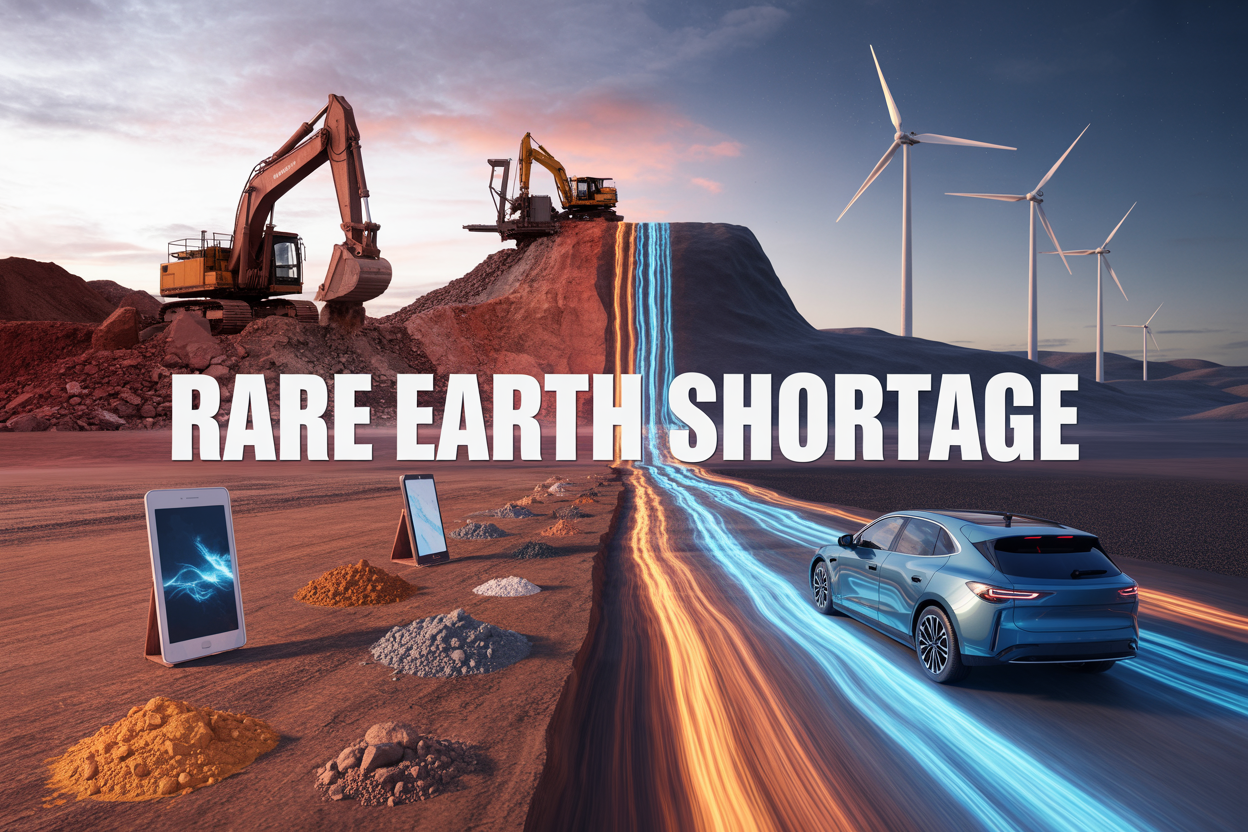Inside the Global Rare Earth Shortage: The Metals Powering Electric Cars, Phones, and the Green Revolution
Your smartphone, Tesla, and the wind turbines dotting the horizon all share something in common: they’re hungry for rare earth elements. These critical minerals supply chain bottlenecks are creating a perfect storm that’s reshaping everything from electric vehicle batteries to the future of clean energy materials.
This deep dive is for business leaders, investors, policymakers, and anyone who wants to understand why rare earth metals have become the new oil of the 21st century. You’ll discover how the rare earth shortage is forcing companies to rethink their strategies and why nations are scrambling to secure their own sources of these essential materials.
We’ll explore how electric vehicles have become the biggest driver of rare earth demand, consuming massive quantities of battery technology metals that were once reserved for smaller devices. You’ll also learn about the economic and geopolitical consequences rippling through global markets as countries compete for control over rare earth mining operations. Finally, we’ll examine the innovative solutions and alternatives being developed to break our dependence on these scarce resources.
The green energy revolution depends on these materials, but the supply can’t keep up with demand. Here’s what that means for your industry, your investments, and your future.
Understanding Rare Earth Elements and Their Critical Role in Modern Technology
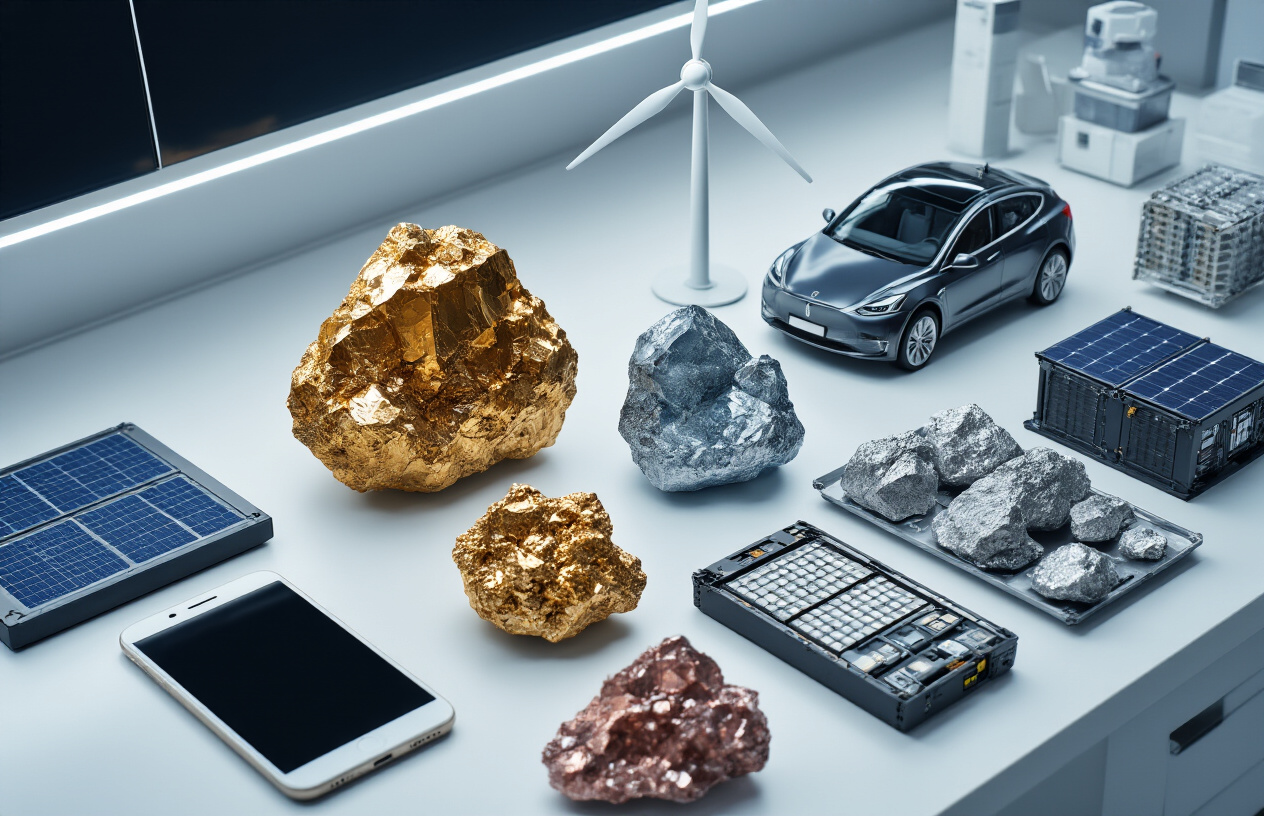
What makes these 17 elements so essential for electronic devices
Rare earth elements are the invisible heroes powering virtually every piece of modern technology we use daily. These 17 metals – 15 lanthanides plus scandium and yttrium – possess unique chemical properties that make them irreplaceable in manufacturing everything from smartphone screens to wind turbine magnets.
Each element serves specific technological functions that conventional metals simply cannot replicate. Neodymium creates the powerful permanent magnets found in hard drives, speakers, and electric vehicle motors. Dysprosium enhances magnet performance at high temperatures, making it critical for electric vehicle batteries and wind turbines. Europium produces the red phosphor in LED displays and fluorescent lighting, while terbium creates the green phosphor. Cerium acts as a polishing compound for glass and semiconductor wafers, and lanthanum improves the refractive index in camera lenses and telescope optics.
The electronics industry depends heavily on these rare earth metals because they enable miniaturization while maintaining performance. A single smartphone contains at least six different rare earth elements, allowing manufacturers to pack incredible computing power into pocket-sized devices. Without rare earths, our phones would be bulkier, less efficient, and significantly more expensive to produce.
Why rare earths are actually abundant but difficult to extract
Despite their name, rare earth elements aren’t particularly rare in terms of abundance. Cerium, the most common rare earth element, appears more frequently in the Earth’s crust than copper. Even the least abundant rare earth, thulium, occurs more often than gold or silver. The “rare” designation stems from their scattered distribution and the extreme difficulty of extracting them economically.
Rare earth mining presents unique challenges that make extraction costly and environmentally hazardous. These elements rarely occur in concentrated deposits like traditional metals. Instead, they’re dispersed throughout various mineral formations, often mixed together in complex compounds. Separating individual rare earth elements requires extensive chemical processing involving acids, solvents, and high-temperature treatments.
The extraction process generates substantial environmental concerns. Mining operations produce radioactive waste because rare earth ores frequently contain thorium and uranium. Processing one ton of rare earth metals can generate up to 2,000 tons of toxic waste, including acidic water that can contaminate groundwater systems. These environmental challenges, combined with strict regulations in many countries, have concentrated rare earth mining in regions with more lenient environmental standards.
China currently dominates global rare earth production not because it holds the largest reserves, but because it developed the infrastructure and accepted the environmental costs associated with large-scale extraction and processing operations.
The unique magnetic and conductive properties driving global demand
Rare earth elements possess extraordinary magnetic and electronic properties that make them essential for advanced technologies driving the clean energy transition. Their unique electron configurations create magnetic moments that are significantly stronger than conventional magnets, enabling the miniaturization of powerful motors and generators.
Neodymium-iron-boron magnets, containing rare earth metals, generate magnetic fields up to ten times stronger than traditional ferrite magnets. This strength allows electric vehicle manufacturers to create compact, lightweight motors that deliver exceptional performance while maintaining energy efficiency. Wind turbine generators rely on these powerful magnets to convert wind energy into electricity efficiently, with a single turbine requiring up to 600 kilograms of rare earth materials.
The conductive properties of certain rare earth elements also enable advanced electronic applications. Indium creates transparent conductive coatings for touchscreens and solar panels. Gallium forms the basis for high-efficiency semiconductors used in LED lighting and advanced computer processors. These elements allow manufacturers to create devices that operate at higher speeds while consuming less energy.
Green energy technology development has dramatically increased demand for these critical minerals. Battery technology metals, including rare earth elements, are essential for energy storage systems that support renewable power grids. As countries worldwide accelerate their transition to clean energy, the demand for rare earth metals continues to outpace supply, creating the current shortage affecting multiple industries.
The Supply Chain Crisis Behind Today’s Rare Earth Shortage

China’s Dominant Control Over 80% of Global Rare Earth Production
China controls roughly 80% of the world’s rare earth elements processing capacity, creating a massive bottleneck in the global supply chain. While countries like Australia, the United States, and Myanmar mine these critical minerals supply chain components, China has strategically positioned itself as the primary processor and refiner. This dominance stems from decades of investment in processing infrastructure and a willingness to accept environmental costs that other nations avoid.
The concentration of processing facilities in China means that even rare earth metals mined elsewhere often travel to Chinese refineries before reaching manufacturers. This creates vulnerability for countries trying to secure their own supply chains for electric vehicle batteries and green energy technology. When China faces internal disruptions or implements policy changes, the entire global market feels the impact immediately.
| Country | Processing Capacity | Key Facilities |
|---|---|---|
| China | ~80% | Inner Mongolia, Sichuan |
| Malaysia | ~8% | Lynas facility |
| Estonia | ~4% | Silmet plant |
| Others | ~8% | Various smaller operations |
How COVID-19 Disrupted Mining Operations and Processing Facilities
The pandemic brought rare earth mining operations to a near standstill across multiple continents. Lockdown measures in China shuttered key processing plants for weeks, while mining sites in Australia and other countries faced workforce shortages and transportation challenges. These disruptions exposed just how fragile the rare earth shortage situation had become.
Processing facilities that remained operational faced reduced capacity due to social distancing requirements and supply chain interruptions for equipment and chemicals needed in refinement processes. The ripple effects reached manufacturers of clean energy materials and battery technology metals within months, as inventory buffers proved insufficient for extended disruptions.
Recovery patterns varied significantly by region. Chinese facilities ramped up production faster than Western counterparts, but global shipping delays and container shortages prolonged the supply chain recovery well into 2022.
Export Restrictions and Trade Tensions Affecting Global Availability
Trade disputes between major economies have weaponized rare earth elements as political tools. China has implemented informal quotas and licensing requirements that effectively control export volumes, while the United States has imposed tariffs and investment restrictions on Chinese rare earth companies.
These tensions pushed countries to seek alternative sources, but the limited number of operational mines outside China means options remain scarce. Japan faced this reality in 2010 when diplomatic tensions led to temporary rare earth export restrictions, spurring long-term efforts to diversify supply chains.
Recent export controls target specific applications and end-users rather than blanket restrictions, making the regulatory landscape complex for manufacturers. Companies producing electric vehicle batteries must navigate constantly shifting rules that can disrupt production planning and increase costs.
Environmental Regulations Limiting New Mining Projects
Environmental concerns significantly constrain new rare earth mining projects worldwide. The extraction and processing of these materials generates toxic waste and requires substantial water usage, making permits difficult to obtain in environmentally conscious regions.
Lithium mining faces similar environmental scrutiny, but rare earth mining presents unique challenges due to radioactive byproducts associated with some deposits. Communities near proposed mining sites often organize opposition campaigns, leading to lengthy legal battles and project delays.
Regulatory approval timelines for new rare earth facilities can stretch 10-15 years in developed countries, compared to 3-5 years in less regulated regions. This timing mismatch between environmental standards and supply urgency continues to favor existing operations over new projects, perpetuating current supply chain vulnerabilities.
Electric Vehicles: The Biggest Driver of Rare Earth Demand
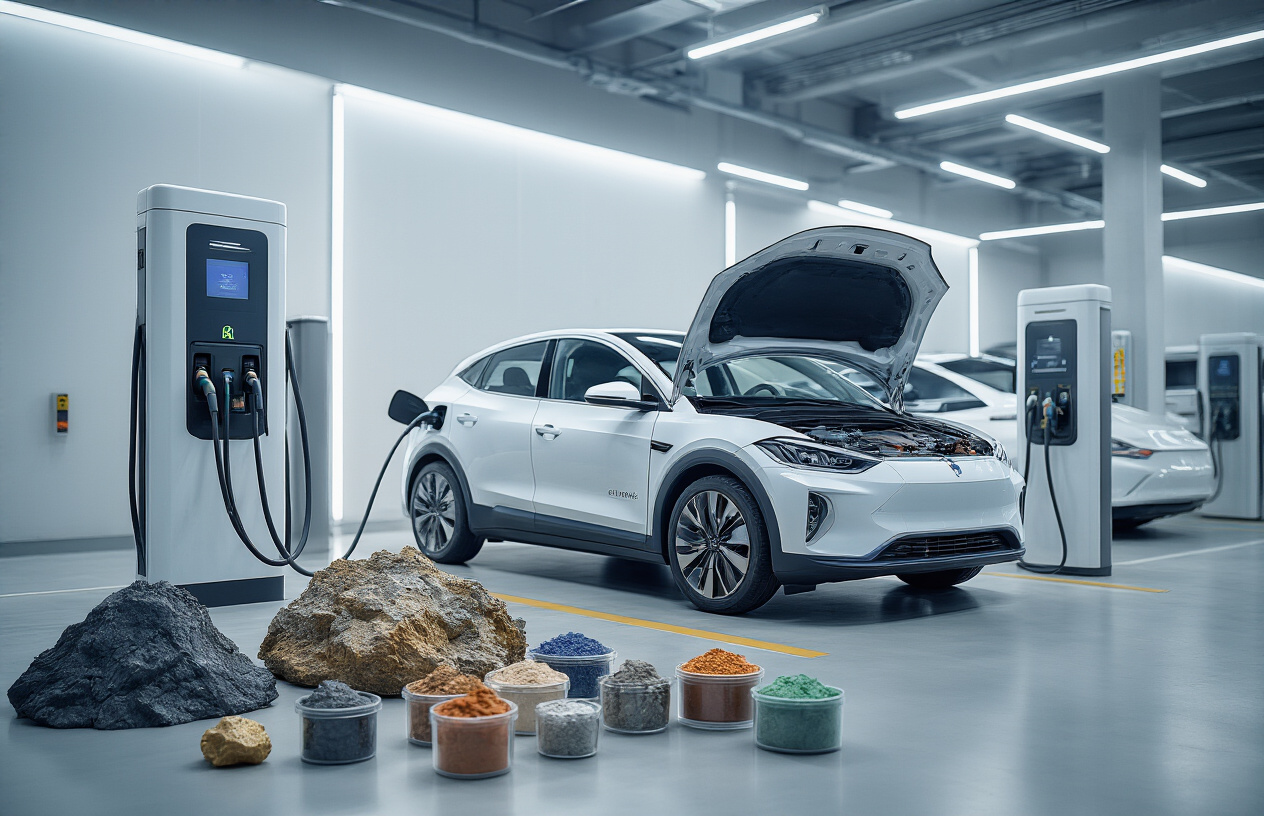
Neodymium and Dysprosium Requirements for EV Motor Magnets
The heart of every electric vehicle lies in its motor, and these motors depend heavily on powerful permanent magnets made from rare earth elements. Neodymium and dysprosium create the strongest permanent magnets available today, making them absolutely essential for EV performance. These magnets generate the magnetic fields that convert electrical energy into the mechanical motion that drives your car forward.
Neodymium-iron-boron magnets form the core of most EV motors, but they face a critical weakness at high temperatures – they lose their magnetic strength. That’s where dysprosium becomes crucial. Adding dysprosium to these magnets dramatically improves their heat resistance, allowing EV motors to maintain peak performance even under demanding conditions like highway driving or climbing steep hills.
A typical EV motor requires approximately 2-4 kilograms of neodymium and several hundred grams of dysprosium per vehicle. The exact amounts vary depending on motor design and power requirements, but the demand remains substantial across all manufacturers. Tesla’s motors, for instance, rely heavily on these rare earth metals to achieve their impressive acceleration and efficiency ratings.
How a Single Tesla Uses 15 Pounds of Rare Earth Materials
When you break down a Tesla’s rare earth consumption, the numbers become staggering. Each Tesla Model S contains roughly 15 pounds of rare earth elements spread across multiple components throughout the vehicle. The drive motor alone accounts for the majority of this usage, consuming about 10-12 pounds of neodymium and dysprosium for its permanent magnets.
Beyond the motor, Tesla vehicles incorporate rare earth metals in their regenerative braking systems, power steering mechanisms, and various sensors. The sophisticated autopilot system relies on multiple cameras and sensors that contain small amounts of rare earth elements for their electronic components.
| Component | Rare Earth Usage |
|---|---|
| Drive Motor Magnets | 10-12 lbs |
| Regenerative Braking | 1-2 lbs |
| Power Systems | 1-2 lbs |
| Electronics/Sensors | 0.5-1 lb |
This 15-pound figure represents just one vehicle. With Tesla producing over 1.8 million cars annually, their rare earth consumption reaches astronomical levels – approximately 27,000 tons of rare earth materials per year for a single manufacturer.
Battery Technology’s Growing Appetite for Lithium and Cobalt
Electric vehicle batteries present an entirely different rare earth challenge. While technically not classified as rare earth elements, lithium and cobalt have become equally critical minerals for the clean energy transition. Lithium-ion batteries power virtually every modern EV, and their hunger for these materials grows with each new model year.
A typical EV battery pack contains 10-15 kilograms of lithium carbonate equivalent and 8-20 kilograms of cobalt, depending on battery chemistry and capacity. Tesla’s larger Model S battery packs can contain up to 63 kilograms of lithium and significant cobalt amounts, though the company has been working to reduce cobalt dependency.
The battery chemistry landscape continues evolving, but current technologies remain heavily dependent on these critical minerals:
- Lithium: Essential for all current battery technologies
- Cobalt: Provides thermal stability and energy density
- Nickel: Increases energy capacity in newer battery designs
- Manganese: Offers safety benefits and cost reduction
Battery manufacturers are exploring alternative chemistries like lithium iron phosphate (LFP) that eliminate cobalt entirely, but these batteries typically offer lower energy density, making them less suitable for long-range vehicles.
Projected EV Growth Creating Unprecedented Material Needs
The rare earth shortage becomes even more concerning when you consider projected EV growth rates. Industry analysts predict global EV sales will reach 30 million units annually by 2030, representing a 300% increase from current levels. This explosive growth translates directly into unprecedented demand for rare earth elements.
Current projections suggest the automotive industry will consume:
- 450,000 tons of neodymium annually by 2030
- 75,000 tons of dysprosium per year by the same timeframe
- 3.2 million tons of lithium carbonate equivalent
- 1.8 million tons of cobalt
These numbers dwarf current production capacity. Global neodymium production currently sits around 30,000 tons annually, meaning we need a 15-fold increase in just eight years to meet automotive demand alone. Dysprosium presents an even bigger challenge, with current production barely reaching 2,000 tons per year.
The math becomes particularly stark when you consider that these projections only account for passenger vehicles. Commercial EVs, electric buses, and electric trucks will add additional pressure to already strained supply chains. A single electric bus can require 2-3 times more rare earth materials than a passenger car due to its larger motors and battery systems.
Chinese manufacturers alone plan to produce 15 million EVs annually by 2025, which would consume more rare earth elements than the entire global production capacity just five years ago. This creates a supply-demand imbalance that threatens to slow the entire green energy transition unless alternative solutions emerge quickly.
Consumer Electronics Fueling the Rare Earth Consumption Surge

Smartphones requiring up to 16 different rare earth elements
Modern smartphones pack an incredible array of rare earth elements into their compact designs. Each device contains neodymium for speakers and vibrating motors, dysprosium for permanent magnets, and europium for the red phosphors in displays. Terbium creates the green phosphors, while yttrium handles the blue ones. The camera system alone requires lanthanum for optical lenses and praseodymium for specialized glass coatings.
The miniaturization trend has actually increased rare earth consumption per device. Manufacturers need more powerful magnets in smaller spaces, requiring higher concentrations of these critical minerals. A single iPhone contains roughly 0.034 grams of rare earth elements, which might seem minimal until you multiply that by the 1.4 billion smartphones sold globally each year.
Touch sensitivity relies heavily on indium and rare earth compounds, while the phone’s ability to maintain signal strength depends on materials like gadolinium and holmium. Even the charging process uses rare earth elements in the phone’s internal circuitry and power management systems.
Why 5G infrastructure demands exponentially more materials
The rollout of 5G networks has created an unprecedented demand spike for rare earth metals. Base stations require significantly more powerful amplifiers and signal processors compared to 4G infrastructure. Each 5G cell tower uses approximately 3-5 times more rare earth elements than its 4G predecessor.
Gallium arsenide semiconductors, essential for 5G’s high-frequency operations, have driven gallium prices up by 40% since 2019. The dense network requirements mean installing 10-100 times more base stations to achieve the same coverage area as traditional cellular networks.
Small cell installations, crucial for 5G’s short-range capabilities, each contain neodymium magnets, yttrium-based ceramics, and europium compounds. With millions of these small cells needed nationwide, the material requirements multiply exponentially. Network equipment manufacturers like Huawei and Ericsson now compete directly with smartphone producers for the same limited rare earth supplies.
The role of rare earths in touchscreens, cameras, and processors
Touchscreen functionality depends entirely on rare earth elements for both responsiveness and durability. Indium tin oxide creates the transparent conductive layer that detects finger movements, while cerium oxide polishes the glass surface to prevent scratches. Without these materials, touchscreens would either be completely non-functional or too fragile for daily use.
Camera systems have become major rare earth consumers as manufacturers push for better image quality. Lanthanum improves lens clarity and reduces chromatic aberration, while praseodymium filters specific light wavelengths for color accuracy. Professional-grade smartphone cameras now use up to 12 different rare earth compounds across their multiple lens systems.
Processor manufacturing consumes massive quantities of high-purity rare earth metals. Yttrium creates specialized ceramics for chip packaging, while europium and terbium enable the precise etching processes needed for nanometer-scale transistors. As processors become more powerful and energy-efficient, they require increasingly pure and expensive rare earth materials, driving up both costs and supply chain pressure across the consumer electronics industry.
Green Energy Technologies Competing for Limited Resources
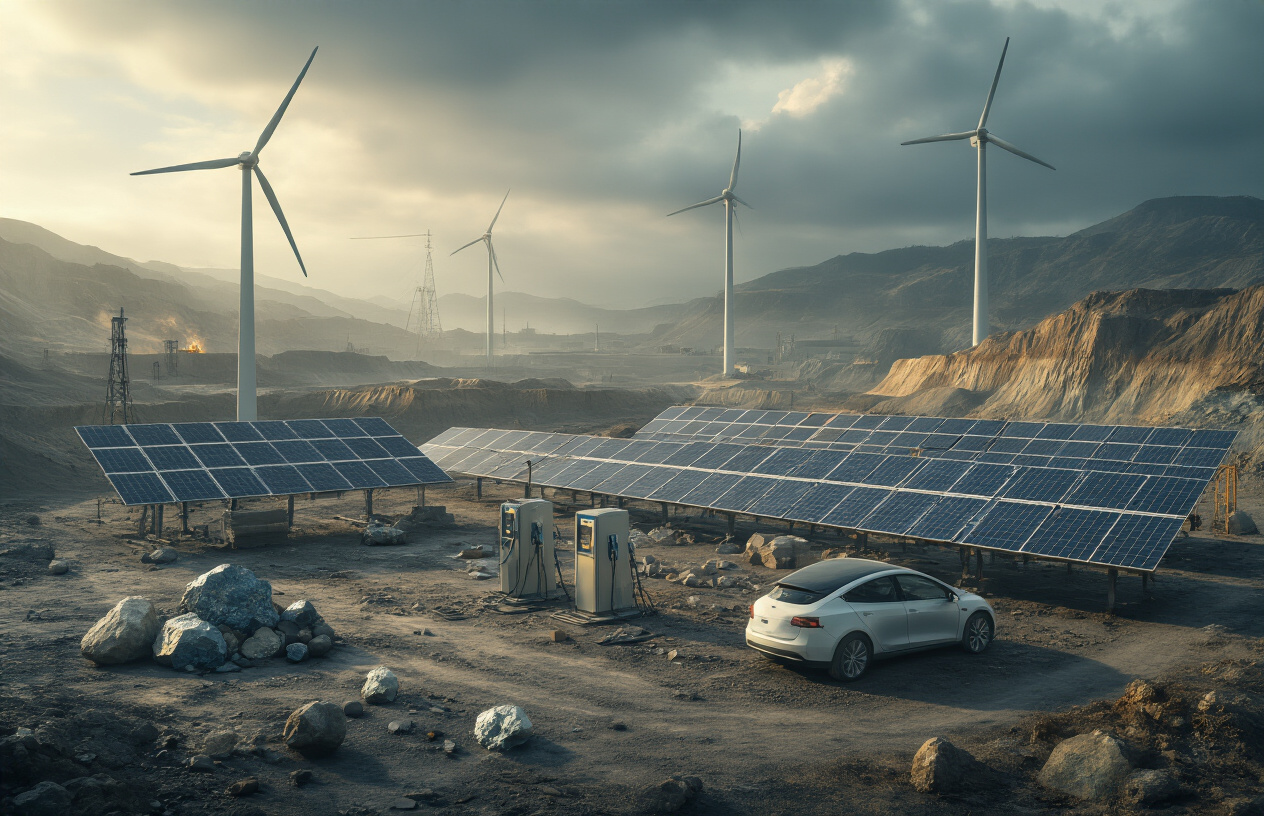
Wind turbines using tons of neodymium for permanent magnets
Modern wind turbines consume massive quantities of rare earth elements, with a single large offshore wind turbine requiring up to 600 kilograms of neodymium for its permanent magnet generator. This creates an intense competition for these critical minerals supply chain resources as countries race to build renewable energy infrastructure.
The permanent magnets in wind turbines rely heavily on neodymium-iron-boron (NdFeB) alloys, which offer the highest magnetic strength available today. These magnets enable turbines to generate electricity efficiently even at low wind speeds, making them essential for offshore wind farms where consistent energy production is crucial. A typical 3-megawatt onshore turbine needs approximately 200 kilograms of neodymium, while the massive 15-megawatt offshore giants can require three times that amount.
Wind energy developers face a challenging dilemma: permanent magnet generators are 20-30% more efficient than traditional geared systems, but they depend entirely on rare earth metals that are becoming increasingly scarce and expensive. Some manufacturers have started exploring hybrid designs that reduce neodymium consumption by 50%, though these compromises in efficiency mean larger turbine installations to achieve the same power output.
The global push for wind energy expansion compounds this challenge. The International Energy Agency projects that wind capacity must triple by 2030 to meet climate goals, translating to hundreds of thousands of additional tons of neodymium demand. China currently controls 85% of global neodymium processing, giving it significant leverage over the green energy technology sector’s future expansion.
Solar panel manufacturing’s dependence on rare earth compounds
Solar panel production relies on several rare earth elements, though in smaller quantities per unit compared to wind turbines. Clean energy materials like cerium oxide play a crucial role in polishing silicon wafers to achieve the mirror-like surface necessary for optimal light absorption. Each solar panel manufacturing facility requires substantial amounts of cerium compounds for this polishing process.
Tellurium, one of the rarest elements on Earth, is essential for thin-film cadmium telluride (CdTe) solar panels, which represent about 20% of the global solar market. These panels offer better performance in hot climates and low-light conditions, making them popular in utility-scale installations. A typical 100-megawatt solar farm using CdTe technology consumes approximately 90-100 tons of tellurium, creating significant pressure on global supplies.
Indium represents another critical bottleneck in solar manufacturing. Copper indium gallium selenide (CIGS) panels, known for their flexibility and high efficiency, require substantial indium inputs. The global indium market produces only about 800 tons annually, yet the solar industry alone could consume 1,200 tons by 2030 if CIGS technology adoption accelerates as projected.
The rare earth shortage has forced solar manufacturers to reconsider their technology choices. Some companies are pivoting back to traditional silicon-based panels to avoid supply chain vulnerabilities, while others are investing heavily in recycling technologies to recover indium and tellurium from end-of-life panels. This shift affects the entire green energy technology landscape, as different solar technologies have varying efficiency rates and installation costs.
Energy storage systems requiring critical mineral inputs
Battery technology metals form the backbone of grid-scale energy storage systems that make renewable energy viable. Lithium-ion batteries, which dominate the stationary energy storage market, require not just lithium but also cobalt, nickel, and various rare earth elements for optimal performance and longevity.
Large-scale battery installations consume enormous quantities of these materials. A 100-megawatt-hour grid storage facility requires approximately 160 tons of lithium carbonate, 35 tons of cobalt, and 80 tons of nickel. As governments mandate renewable energy integration, the demand for grid storage is exploding. California alone has mandated 11,500 megawatt-hours of storage capacity by 2026, representing a massive draw on already constrained rare earth metals supplies.
Flow batteries, considered a promising alternative for long-duration storage, present their own rare earth challenges. Vanadium redox flow batteries require substantial amounts of vanadium, a metal where global production struggles to keep pace with growing demand. A single 10-megawatt-hour vanadium flow battery system needs roughly 250 tons of vanadium pentoxide, enough to supply a small steel mill for months.
The competition between electric vehicle batteries and stationary storage systems creates a complex dynamic in rare earth markets. Both sectors are growing exponentially, but stationary storage systems typically have longer lifespans and different performance requirements. This has led to increased research into alternative battery chemistries like iron-air and zinc-bromine systems that rely on more abundant materials, though these technologies are still years away from commercial viability at scale.
Critical minerals supply chain constraints are forcing energy storage developers to secure long-term contracts directly with mining companies, bypassing traditional commodity markets. Some utilities are even investing directly in lithium mining operations to ensure supply security for their renewable energy projects, fundamentally changing how the energy sector approaches resource procurement.
Economic and Geopolitical Consequences of the Shortage
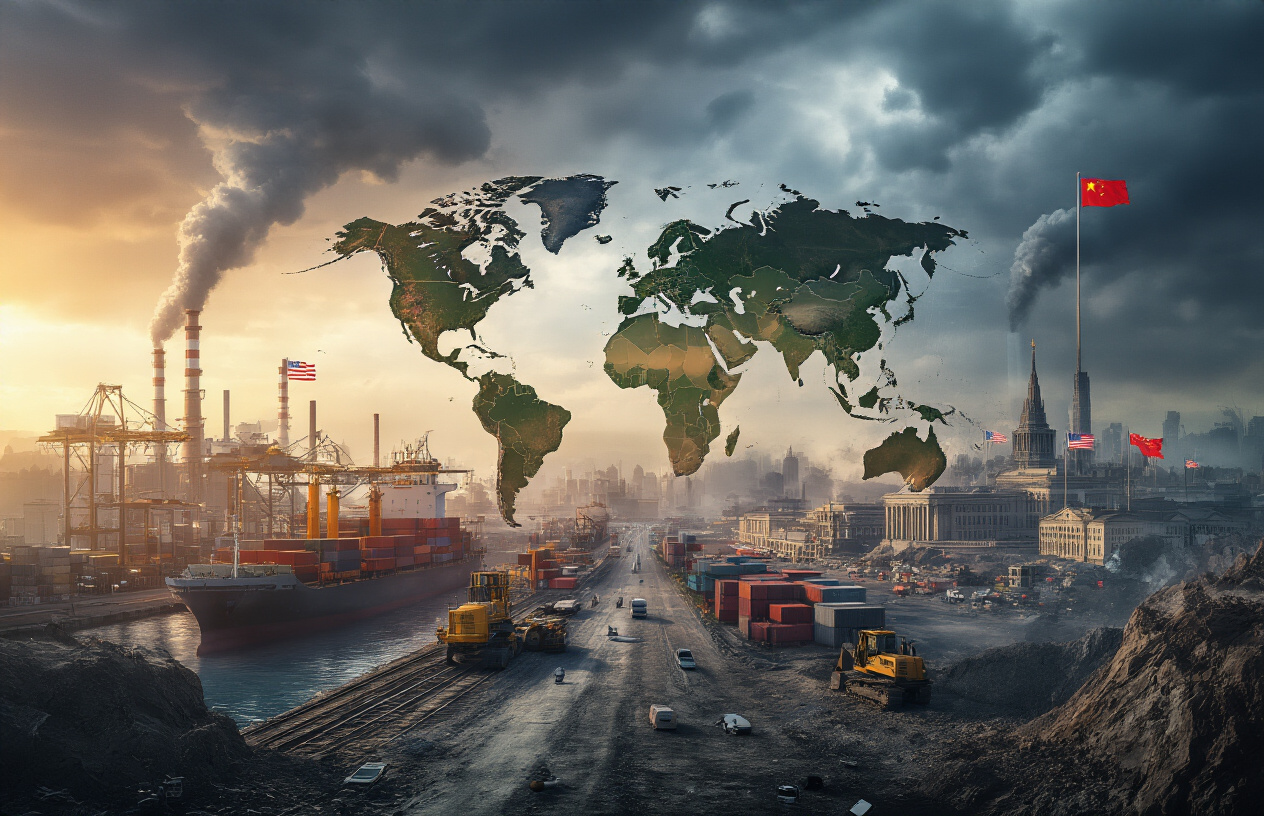
Price volatility affecting manufacturing costs across industries
The rare earth shortage has turned pricing into a rollercoaster ride that’s giving manufacturers serious headaches. Neodymium prices have swung from $50 per kilogram to over $150 within a single year, making it nearly impossible for companies to create reliable budgets. This volatility hits hardest in sectors already dealing with tight margins.
Car manufacturers building electric vehicles face the biggest challenge. Tesla and Ford have both reported that rare earth metal price swings can add $500 to $2,000 to the cost of each vehicle, depending on battery size and motor specifications. When neodymium prices spiked 40% in early 2023, several automakers had to either absorb the costs or pass them to consumers through higher sticker prices.
Electronics companies aren’t faring much better. Smartphone manufacturers need consistent pricing to maintain their razor-thin profit margins, but rare earth elements like terbium and europium – essential for screen displays – have seen price increases of 200-300% over the past two years. Apple and Samsung have both cited rare earth metals as a significant factor in their supply chain cost management challenges.
The renewable energy sector faces similar pressures. Wind turbine manufacturers rely heavily on rare earth permanent magnets, and when prices jump unexpectedly, project financing becomes complicated. Many green energy projects that looked profitable at initial planning stages are now struggling with cost overruns directly tied to rare earth metal price volatility.
Supply chain vulnerabilities exposing national security risks
Countries worldwide are waking up to a uncomfortable reality: their technological sovereignty hangs on access to rare earth elements, and the supply chain is dangerously concentrated. China controls roughly 85% of global rare earth processing capacity, creating what defense experts call a “single point of failure” for critical technologies.
The national security implications run deep. Military equipment from fighter jets to missile guidance systems depends on rare earth metals. F-35 fighter jets contain about 920 pounds of rare earth materials, while a typical nuclear submarine uses around 9,000 pounds. When supply chains tighten, defense contractors face delays that can stretch for months or even years.
The United States has been particularly vocal about these vulnerabilities. The Pentagon’s latest supply chain assessment identified rare earth elements as the top strategic material risk, ranking even higher than oil dependency. European nations are equally concerned – the EU launched its Critical Raw Materials Act specifically to reduce dependence on single suppliers for rare earth elements.
Japan learned this lesson the hard way during a 2010 diplomatic dispute with China that temporarily cut off rare earth exports. Japanese electronics giants like Sony and Panasonic faced production shutdowns within weeks, highlighting how quickly these dependencies can become strategic liabilities. The incident sparked global awareness about supply chain diversification needs.
How shortages are delaying renewable energy projects worldwide
The green energy transition is hitting a major speed bump because of rare earth shortages. Wind farms, solar installations, and energy storage projects are facing delays that push back clean energy goals by months or years.
Wind power projects are getting hit particularly hard. A single 3-megawatt wind turbine requires about 600 kilograms of rare earth materials for its permanent magnet generator. With global wind installations planned to triple by 2030, the demand far exceeds current rare earth production capacity. Several major wind farms in Europe and North America have already pushed back their completion dates by 6-12 months due to magnet shortages.
Electric vehicle charging infrastructure is another casualty. Fast-charging stations need rare earth metals for their power conversion systems, and the shortage is slowing down the buildout of charging networks. California’s plan to install 250,000 charging stations by 2025 is now considered unrealistic given current supply constraints.
Energy storage projects face similar challenges. Grid-scale battery installations require significant amounts of lithium and rare earth elements, but mining operations can’t keep pace with demand. Some utility companies are redesigning their energy storage plans to use alternative technologies that require fewer critical minerals, though these often come with performance trade-offs.
The irony isn’t lost on policymakers: the materials needed to fight climate change are becoming the bottleneck that slows down climate solutions. This has sparked urgent discussions about mining policy, recycling programs, and alternative material research across governments worldwide.
Solutions and Alternatives Being Developed to Address the Crisis

Recycling programs recovering rare earths from electronic waste
Electronic waste recycling has become a goldmine for rare earth recovery, transforming discarded phones, laptops, and other devices into valuable resource streams. Companies like Apple and Samsung now operate sophisticated recycling programs that extract rare earth elements from millions of devices annually. Apple’s Daisy robot can disassemble 200 iPhones per hour, recovering rare earths alongside other precious metals.
Urban mining facilities across Japan, South Korea, and Germany have pioneered advanced separation techniques that can recover up to 95% of rare earth elements from electronic waste. These facilities use chemical leaching processes combined with magnetic separation to isolate neodymium, dysprosium, and other critical materials from hard drives and speakers.
The economics are compelling – recycling one ton of electronic waste yields more rare earth elements than processing several tons of ore. Major recycling operations in China process over 70% of the world’s e-waste, though environmental concerns have pushed Western nations to develop domestic capabilities.
Battery recycling specifically targets electric vehicle batteries, which contain substantial amounts of rare earth metals. Redwood Materials and Li-Cycle have built industrial-scale operations that process thousands of EV batteries monthly, creating closed-loop supply chains for automakers.
New mining projects opening in Australia, Canada, and the US
Western nations are racing to establish domestic rare earth mining operations to reduce dependence on Chinese suppliers. Australia leads this charge with the Mount Weld mine operated by Lynas Corporation, which produces roughly 12% of global rare earth supply outside China.
Canada’s Vital Metals has developed the Nechalacho project in the Northwest Territories, targeting heavy rare earth elements that command premium prices. The Saskatchewan Research Council operates North America’s only rare earth processing facility, creating a complete domestic supply chain from mining to refined materials.
The United States has revived the Mountain Pass mine in California, previously the world’s largest rare earth producer before Chinese competition forced its closure. MP Materials now produces about 15% of global rare earth concentrate, with plans to establish full processing capabilities by 2025.
New discoveries continue emerging across these regions. Australia’s Arafura Resources is developing the Nolans Project, while Canada’s Appia Energy explores uranium-rare earth deposits in Saskatchewan. These projects benefit from government support through critical minerals initiatives and defense-related funding.
Environmental standards in these Western operations exceed typical Chinese mining practices, though extraction costs remain higher. Advanced processing technologies and automation help offset labor cost disadvantages while meeting stricter environmental regulations.
Research into alternative materials and magnet-free technologies
Scientists worldwide are developing breakthrough alternatives to rare earth-dependent technologies, potentially reshaping entire industries. Researchers at Cambridge University have created iron-nitrogen magnets that match neodymium performance without rare earth elements, opening possibilities for rare earth-free electric motors.
Motor manufacturers are exploring switched reluctance motors and induction designs that eliminate permanent magnets entirely. Tesla’s Model S now uses an induction motor for its rear axle, reducing rare earth consumption while maintaining performance. These magnet-free designs sacrifice some efficiency but offer supply chain security.
Advanced materials research focuses on creating synthetic alternatives to rare earth phosphors used in LED lighting and display screens. Quantum dots and organic light-emitting compounds show promise for replacing rare earth-based materials in consumer electronics, though commercial viability remains several years away.
Battery technology research aims to reduce or eliminate rare earth elements in clean energy storage. Lithium iron phosphate batteries, already popular in China, contain no rare earths while offering competitive performance for many applications. Solid-state battery designs promise even greater material flexibility.
Additive manufacturing techniques now create complex magnetic structures using common materials, potentially replacing rare earth magnets in specific applications. 3D printing allows precise control over magnetic field patterns, compensating for weaker materials through optimized geometries.
Biotechnology offers unexpected alternatives through engineered bacteria that produce magnetic nanoparticles, though this research remains in early stages. These biological approaches could eventually create sustainable alternatives to mined rare earth materials.

The rare earth shortage isn’t just a supply chain hiccup—it’s reshaping entire industries and forcing us to rethink how we build the technology that runs our lives. From the electric cars we’re rushing to buy to the wind turbines powering our cities, these seventeen little-known metals have become the bottleneck for our clean energy dreams. The competition between electric vehicle manufacturers, smartphone makers, and renewable energy companies has created a perfect storm where demand is skyrocketing while supply chains remain dangerously concentrated.
The good news is that companies and researchers aren’t sitting idle. Recycling programs are getting smarter, alternative materials are being developed, and new mining projects are finally getting the green light outside traditional supply regions. If you’re investing in green technology stocks or planning your next electric vehicle purchase, keep an eye on how these companies are securing their rare earth supply chains. The winners in tomorrow’s green economy will be those who solve this puzzle first.










